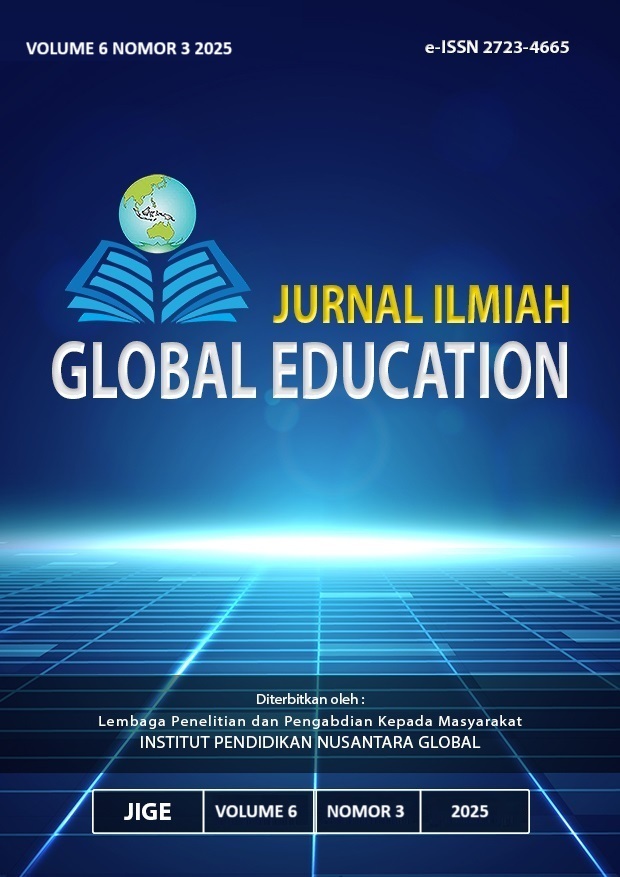Educational Strategy in Preserving and Developing Malay Islamic Arts and Culture
DOI:
https://doi.org/10.55681/jige.v6i3.3979Keywords:
Islamic Cultural Education, Malay Art Preservation, Cultural Development StrategyAbstract
This research is motivated by concerns over the diminishing existence of Malay Islamic arts and culture amid globalization and the lack of appreciation from the younger generation. The main objective of this study is to formulate strategies for preserving Malay Islamic cultural arts so that they remain relevant in the modern era. This study employs a qualitative approach using a literature review method. Data were collected from various written sources and analyzed through content analysis to identify applicable preservation strategies. The results of the study reveal six main strategies: education and socialization, cultural festivals, digital documentation, artist development, cultural filtering, and the use of social media. Collaboration among academics, the government, and the community is key to successful preservation. These findings indicate that the preservation of Malay Islamic cultural arts requires an adaptive approach based on local wisdom and digital technology, which can enhance cultural awareness and strengthen the identity of the younger generation amid the challenges of globalization.
Downloads
References
Amalia, W. P., Sumarwati, S., & Setiawan, B. (2019). Utilization of social care values of folk tales in Purbalingga Regency as the development of character education in Indonesian language learning. Basastra: Journal of Language, Literature, and Its Teaching, 6(2), 203. https://doi.org/10.20961/basastra.v6i2.37707
Aulia, S., & Agustin, H. Y. (2020). The value of perseverance in the tradition of dindang for children in the Banjar community. Jurnal XYZ, 4(1), 65–78.
Humairah, S. (2019). The efforts of Riau Malay culture subject teachers to form the morals of Islamic religious education students at State Elementary School 3 Pekanbaru (Unpublished thesis). Islamic University of Riau, Faculty of Islamic Studies.
Intangible Cultural Heritage of Indonesia. (n.d.). Riau Malay cultural database. https://warisanbudaya.kemdikbud.go.id
Nasution, S. N. (2019). Implementation and efforts of Islamic education teachers in instilling multicultural values in State Senior High Schools in Pematangsiantar City (Unpublished thesis).
Rahim, N. A., Samsudin, S. F., & Alim, M. A. (2021). Preservation of Islamic arts in Malay communities: Challenges and strategies. Journal of Islamic Arts and Culture, 5(1), 45–60.
Riau Provincial Cultural Service. (2023). Annual report of Riau cultural preservation activities 2023.
Sabri, S. (2020). Influence of Islam on Malay traditional art: A cultural study. Southeast Asian Journal of Cultural Studies, 3(2), 89–105.
Sairin, A. (2004). Malay cultural heritage and identity preservation. Kuala Lumpur: University Press.
Sirulhaq, M., & Kurniawan, D. (2024). Impact of globalization on Malay cultural identity among youth. International Journal of Cultural Studies, 12(1), 15–27.
Sugiyono. (2013). Quantitative, qualitative, and R&D research methods. Bandung: Alfabeta.
Triana, D., & Fatika Sari, N. (2023). Adaptive strategies for preserving Malay culture in the digital era. Journal of Southeast Asian Studies, 10(1), 34–50.
Utami, R. (2019). Cultural shifts in Malay society: Preservation challenges. Journal of Indonesian Cultural Heritage, 6(2), 75–88.
Wirianto, A. (2018). The meaning and influence of folklore for the community of Nagari Selayo, Solok Regency. Suluah, 21(1), 92–104.
Zainuri, M., Mahfayeri, S., Suparman, D., & Setyawan, D. (2017). Malay culture with integrity. Riau: Human Resources Development Agency.
Downloads
Published
How to Cite
Issue
Section
License
Copyright (c) 2025 Neng Sufia, Haris Riadi, Gusti Erlina, Rahmad

This work is licensed under a Creative Commons Attribution-ShareAlike 4.0 International License.












